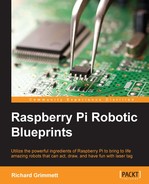Robotics have really come into the public spotlight in the past few years. Ideas that, just a few years ago, would have lived only in the government research center or university lab, such as robotic vacuum cleaners, drones that cover the sky, and self-driving cars, are now making their way into everyday life. This movement is fueled, at least in part, by scores of enterprising individuals, without significant technical training, who undertake building their idea with inexpensive hardware and free, open-source software.
This book celebrates this effort by detailing how to get started on building the project that you always wanted to build but didn't think you had the expertise for. The heart of these projects is Raspberry Pi B version 2, a cable microprocessor-based system that can run Linux and provides a platform for a significant number of open source modules. Combine Raspberry Pi with these open source modules and low cost hardware, and you can build robots that can walk, role, draw, and even fly.
Chapter 1, Adding Raspberry Pi to an RC Vehicle, shows you how to add Raspberry Pi to an existing toy, such as an old RC car or truck, to make it "new" again.
Chapter 2, Adding Raspberry Pi to a Humanoid Robot, covers how to add Raspberry Pi to robots, such as the Robosapien line from WowWee, to add voice commands and make them more versatile.
Chapter 3, Building a Tracked Vehicle That Can Plan Its Own Path, explains how to build a tracked robot containing sensors so that it can map the position of a set of objects.
Chapter 4, Building a Robot That Can Play Laser Tag, covers how to use the capabilities of Raspberry Pi to build a wheeled robot that can play laser tag.
Chapter 5, A Robot That Can Draw, introduces the capability of external dedicated servo controllers that can make controlling the arms and legs of the robot much easier. This is done using servos, whose position can be controlled using our system.
Chapter 6, A Robot That Can Play Air Hockey, explains how to use stepper motors and an advanced vision system to build a robot that can plan air hockey using more power and precision.
Chapter 7, A Robot That Can Fly, explains that after building a robot that can walk, talk, or play air hockey, you can build a robot that can fly.
